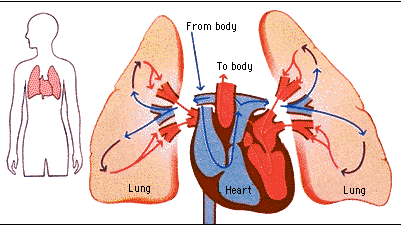How do the respiratory and circulatory systems keep tissues all over your body alive?
1 Answer
Together they bring oxygen to the cells of the body.
Explanation:
Cells have some basic requirements to stay alive and among the most important is oxygen. In a sense, cells need to breathe.
But there's a problem - most cells within us have no immediate connection with the outside world and so they can't get oxygen on their own. They need the Oxygen Delivery Man!
The body has a pair of lungs (the main component of the Respiratory System ) that can gather all the oxygen needed by the body, but there needs to be a way to get it to the cells.
And so blood (the Circulatory System) is pumped by the Heart and it passes through the lungs, grabs the oxygen, and transports it to the cells of the body . And while it's at it, blood grabs the carbon dioxide the cells don't want and bring it back to the lungs to be breathed out.

The diagram above shows the process. Find the label "From body" - this is the blood carrying the carbon dioxide back from the cells. That blood passes through two chambers of the Heart and then enters the lungs. The carbon dioxide is released into the Lungs and oxygen is absorbed by the blood (see the colour change from blue to red in the diagram). That oxygen-rich blood is then sent off to the body for use to breathe.

